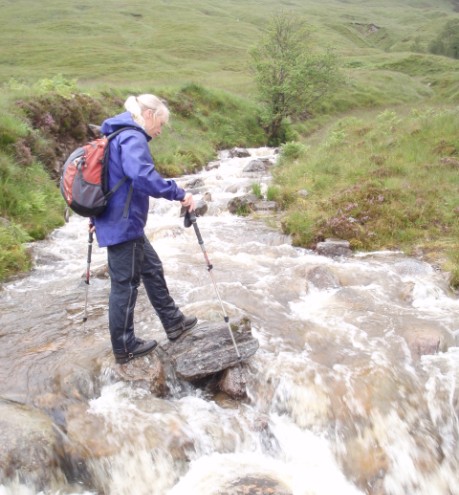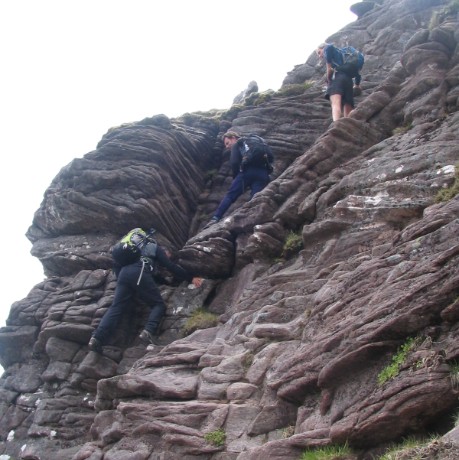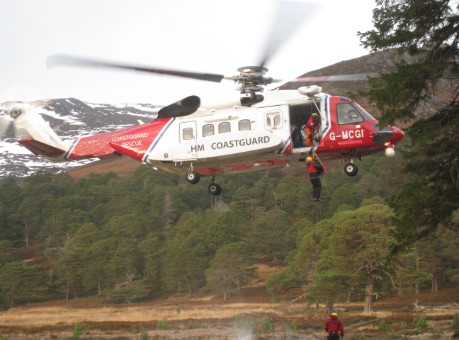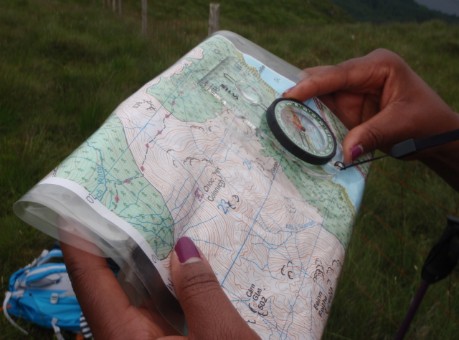You've made your plans and the big day has arrived. And sooner or later you'll find the truth in Burn's aphorism that "the best laid plans o' mice and men gang aft agley". That's when you discover the value of having spent time studying the map and making alternative plans. A mountain day is seldom a case of clutching a single route plan to your chest and following the line regardless. Weather, unforeseen difficulties on the ground and the performance of you and your companions all add variables which may dictate changes to your original route.

A key place is a specific place where you may have to make a decision if the day isnít going according to plan. For example, if you and your group arenít moving as fast as expected, or the weather is worse than forecast etc.
That decision will be whether to continue with your route or to switch to an alternative. For example, you may have identified a river crossing as a key place. If you can cross safely, then carry on with your planned route, but if the river proves impassable then you should have an alternative plan in mind, whether that involves a different route which avoids crossing the river or whether itís simply to go back the way you have come. It could also be a section of steep ground where you have to make a decision whether your party is capable of continuing or should opt for a planned alternative. The important thing is that you have identified your key places in advance and know exactly what to do when you get there.
A key place neednít be a potential hazard, it could just be a col between two hills on a ridge youíre following, where an alternative route can be taken to shorten the walk if weather is worsening or if any of the party is tiring.
It might also be a halfway point, or the most distant point from the start/finish of a circular walk: if you havenít reached it by a set time then you know you will be later back than planned, so can decide whether to alter the route or turn back.
Key places identified in the planning stage arenít the only points where a switch to an alternative route may be decided on. If, for example, the weather turns unexpectedly bad, or it becomes apparent that a member of the party will not be able to walk the full distance, a decision to switch to an alternative route can be made at any stage. However it is likely that you will have to carry on to the next key place or go back to the previous one to make the route change.
External factors like weather and terrain arenít the only things which can result in resorting to an alternative plan. Any group of walkers is going to have stronger and weaker members, and some who are more or less experienced and skilled than others, and allowance should always be made for this.
Fellow group members should always be looking out for each other throughout the day, but in particular at key points where there may be a particular difficulty some may struggle with or where there is a convenient place to cut short a route that is becoming too much for them.
While people may often respond well to a little encouragement, donít force someone on beyond their confidence or abilities. Better to shorten a journey or take a less technical detour than to force someone on and end up having an accident.

Heuristics is a word thatís become popular amongst mountain safety experts in recent years, with Ďheuristic trapsí a danger to be warned against. So what are 'heuristics traps', and why are they dangerous?
Heuristics can be mental shortcuts that ease the load of making a decision. You might say using a rule of thumb, an educated guess, an intuitive judgement, or a guesstimate Ė or even common sense. Theyíre tactics that can help in making quick decisions where you donít always know all the facts or donít have time to fully evaluate them. And they can be very handy.
But in a mountain environment they can be dangerous, or even deadly.
There are four key forms of heuristic trap that people fall victim to in the mountains:
Commitment: Once youíve made your plan you stick to it.
However, circumstances may have changed. The weather may have deteriorated, a river may unexpectedly be in flood, a member of the group might have developed bad blisters. The heuristic trap is that, having set the goal and made the plans, you carry on regardless, without further consideration. But you should be evaluating the situation throughout the day and, if circumstances change, then you need to give careful thought to whether your plan should change too.
Familiarity: You may have walked a section of your route before, or you may be familiar with the stepping stones across a river.
However just because youíve done something before doesnít mean the potential hazards you encountered the first time arenít still there now, or may even have changed.
Scarcity: Youíve not been able to get away for months, but this weekend you have a free pass and are determined to tackle that challenging scramble youíve had your eye on all these years. Itís a no brainer.
Itís not a no brainer at all. If the forecast is for high winds or rain then that scrambling route is probably the worst choice you could make. Just because the opportunity doesnít arise very often doesnít mean you should blunder ahead with a poor plan.
Social proof: Youíve just seen someone else do it, so it must be okay.
You may have just watched someone walk out onto a spring snow cornice to get a better view; that doesnít mean the cornice wonít collapse the next time someone steps onto it. Or you saw someone scrambling up a rocky section of the route you were having second thoughts about; that doesnít mean you should go ahead and do it despite your fears Ė you have no idea how that personís skills and abilities compare to your own.
Avoiding heuristic traps is a case of being aware that they exist and not blindly following someone else or being too lazy to think things through. Before taking anything that could be considered a risk you need to ask yourself whether youíve weighed up the risks and benefits or whether youíre just telling yourself everything will be fine.
Ask anyone in a mountain rescue team and they'll tell you that a lot of call-outs are caused by people making all the same mistakes. So there can be a lot of value in reading about the mistakes other people have made and learning the lessons - so that you don't go on and make the same mistake yourself.
Weíve collected a number of tales where people have made errors of judgement in the mountains and describe where they went wrong and what they could have done better.


Poor navigation remains a common cause of mishaps and call-outs for mountain rescue teams.
If your navigation skills aren't up to scratch then you should consider taking a navigation course to improve or refresh your knowledge. Mountaineering Scotland offers courses from just £35 for our members, from basic navigation through to night and winter navigation.
Making decisions isn't always easy when you lack experience. But with more information behind you, the decision-making process comes easier.
Sofa 2 Summit is a new online program from Mountaineering Scotland to help you get the most out of hiking in the hills this spring and summer.
It's for people new to hiking who wants to explore Scotland's hills and mountains, or anyone who wants to learn a bit more or take a refresher after a break from hill walking during lockdown.
Register now to get started on this 7 week program and let us help you get from sofa to summit!
